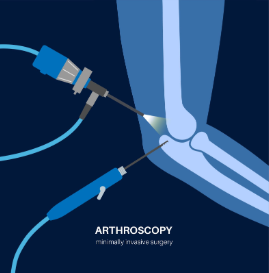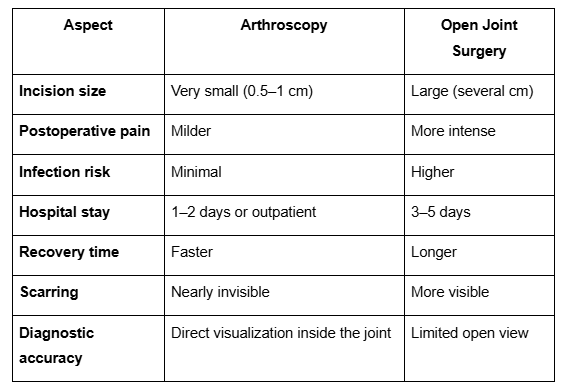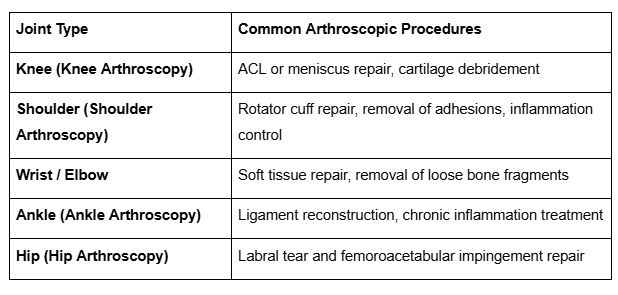By : Geraldus Sigap

What Is Arthroscopy?
Arthroscopy is a minimally invasive surgical procedure used to diagnose and treat various joint disorders, including the knee, shoulder, wrist, elbow, ankle, and hip. Through a small keyhole-sized incision, the surgeon inserts a high-resolution camera (arthroscope) and specialized surgical instruments to view and treat the inside of the joint directly.
This modern procedure provides high accuracy with minimal scarring and faster recovery time compared to traditional open joint surgery.
When is Arthroscopy Needed?
Doctors usually recommend arthroscopy when physical examinations and imaging tests such as X-rays or MRIs cannot clearly identify the cause of joint pain.
It can be performed for both diagnostic and therapeutic purposes in a single procedure.
Conditions that can be treated with arthroscopy include:
- Torn knee ligaments or meniscus
- Rotator cuff tears in the shoulder
- Arthritis or joint inflammation
- Synovial diseases or abnormal tissue growth
- Removal of loose bone or cartilage fragments
- Joint injuries from trauma or degeneration
Advantages of Arthroscopy Compared to Conventional Surgery

How is Arthroscopy Performed?
- General anesthesia is administered to ensure the patient remains completely comfortable and pain-free throughout the procedure
- The surgeon makes a small incision to insert the arthroscope camera.
- The interior of the joint is displayed in real-time on a monitor.
- Using specialized instruments, the surgeon can repair damaged tissue, remove loose cartilage, or reconstruct ligaments.
- After the procedure, the small incisions are closed with one or two stitches.
- Most arthroscopies take about 30–90 minutes, depending on the joint and the extent of the damage.
Joints Commonly Treated with Arthroscopy

Benefits of Arthroscopy for Patients
- Tiny incision and faster wound healing
- Less postoperative pain
- Lower risk of bleeding and infection
- Shorter hospital stay and faster recovery
- Quicker return to daily activities or sports
- Ideal for athletes, active individuals, and seniors
Recovery After Arthroscopy
Most patients can go home the same day or the next day after surgery. Full recovery depends on the type of joint and procedure performed.
General recovery tips:
- Rest the joint and avoid strenuous activity for several days
- Apply cold compresses to reduce swelling
- Perform gentle stretching or range-of-motion exercises as directed
- Continue rehabilitation or physiotherapy sessions to restore muscle strength and joint mobility
RS Abdi Waluyo is also equipped with a dedicated Rehabilitation Center, providing personalized physiotherapy and recovery programs to help patients regain strength, flexibility, and confidence after surgery. If you or a family member are experiencing persistent joint pain, sports injuries, or limited mobility in the knee, shoulder, or ankle, don’t ignore the symptoms. Consult the Orthopedic Specialist Team at RS Abdi Waluyo today, Arthroscopy could be the modern solution to restore your movement and quality of life. Call 021-3144989 or make an appointment online via https://abdiwaluyo.com/ today.
FAQ
- Is arthroscopy painful?
No. Arthroscopy is performed under general anesthesia, so patients do not feel pain during the procedure. Some mild soreness or swelling may occur afterward, which can be managed with medication and rest.
- How long does recovery take after arthroscopy?
Most patients can resume light activities within a few days and return to full function within 4 – 6 weeks, depending on the type of joint treated and the complexity of the procedure.
- Are there any risks to arthroscopy?
As with any surgery, there are minimal risks such as infection or stiffness, but these are rare. With experienced orthopedic surgeons and sterile techniques, the risk is very low.
- When can I start physiotherapy after surgery?
Physiotherapy typically begins a few days after the procedure. The Rehabilitation Center at RS Abdi Waluyo offers customized recovery plans supervised by physiotherapists to ensure optimal healing.
- Can arthroscopy be done for both diagnosis and treatment?
Yes. Arthroscopy allows doctors to see inside the joint and, if needed, treat the problem immediately using specialized instruments, all within the same session.
Resource :
- LaPrade, R. F., Spalding, T., Murray, I. R., Chahla, J., Safran, M. R., Larson, C. M., Faucett, S. C., von Bormann, R., Brophy, R. H., Maestu, R., Krych, A. J., Firer, P., & Engebretsen, L. (2020). Knee arthroscopy: evidence for a targeted approach. British journal of sports medicine, 55(13), 707–708. Advance online publication
- InformedHealth.org [Internet]. Cologne, Germany: Institute for Quality and Efficiency in Health Care (IQWiG); 2006-. Osteoarthritis of the knee: Research summaries – Does arthroscopy help in osteoarthritis of the knee? [Updated 2024 May 15]. Available from: https://www.ncbi.nlm.nih.gov/books/NBK544979/
